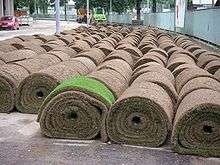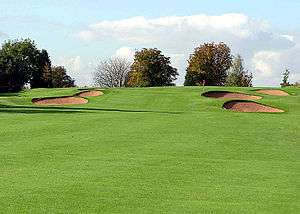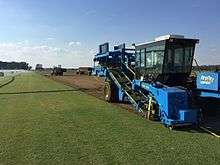Sod
Sod or turf is grass and the part of the soil beneath it held together by its roots or another piece of thin material.




In Australian and British English, such material is more usually known as turf, and the word "sod" is limited mainly to agricultural senses.
Uses
Sod is typically used for lawns, golf courses, and sports stadiums around the world. In residential construction, it is sold to landscapers, home builders or home owners who use it to establish a lawn quickly and avoid soil erosion. Sod can be used to repair a small area of lawn,[1] golf course, or athletic field that has died. Sod is also effective in increasing cooling, improving air and water quality, and assisting in flood prevention by draining water.[2]
Scandinavia has a long history of employing sod roofing and a traditional house type is the Icelandic turf house.
Following the passage of the Homestead Act by Congress in 1862, settlers in the Great Plains used sod bricks to build entire sod houses.[3] This was effective because the prairie sod of the Great Plains was so dense and difficult to cut it earned the nickname "Nebraska marble". Blacksmith John Deere made his fortune when he became the first to make a plow that could reliably cut the prairie sod.[4]
Different types of grass used for sod installation [5]
Cultivation
Sod is grown on specialist farms. For 2009, the United States Department of Agriculture reported 1,412 farms had 368,188 acres (149,000.4 ha) of sod in production.[6]
It is usually grown locally (within 100 miles of the target market)[7] to minimize both the cost of transport and also the risk of damage to the product. The farms that produce this grass may have many varieties of grass grown in one location to best suit the consumer's use and preference of appearance.
It is usually harvested 10 to 18 months after planting, depending on the growing climate. On the farm, it undergoes fertilization, frequent mowing, watering, and subsequent vacuuming to remove the clippings. It is harvested using specialized equipment, precision cut to standardized sizes. Sod is typically harvested in small square or rectangular slabs, or large 4-foot-wide (1.2 m) rolls.
Mississippi State University has developed a hydroponic method of cultivating sod. For the very few sod farms that export turf internationally, this soilless sod may travel both lighter and better than traditional sod. Additionally, since the sod is not grown in soil, it does not need to be washed clean of soil down to the bare roots (or sprigs), so time to export is shortened.[8]
Immediacy
In many applications, such as erosion control and athletic fields, immediacy is a key factor. Seed may be blown about by the wind, eaten by birds, or fail because of drought. It takes some weeks to form a visually appealing lawn and further time before it is robust enough for use. Turf largely avoids these problems, and with proper care, newly laid sod is usually fully functional within 30 days of installation and its root system is comparable to that of a seeding lawn two or three years older.[9] Sod reduces erosion by stabilizing the soil.[10]
Many prized cultivars (such as Bella Bluegrass) only reproduce vegetatively,[11] not sexually (via seed). Sod cultivation is the only means of producing additional plants. To grow these varieties for sale, turf farms use a technique called sprigging, where recently harvested sod mats are cut into slender rows and replanted in the field.
Cultivars used
Fescue grass
Tall fescue
Tall fescue (Festuca spp.) is a cool-weather group of grasses originating in Europe, commonly used as sod. It exhibits moderate tolerance to both drought and cold, and as such is especially popular in inland temperate environments referred to in the turf and landscaping industries as the "transition zone", where summers are too hot for most cool-weather grasses, yet winters are too cold for most warm-weather grasses. Fescue is well-adapted to clay soils, moderately shade-tolerant, and somewhat resistant to disease, yet still vulnerable to brown patch and Fusarium patch. It grows most actively (and thus provides the most desirable appearance) in spring and fall, and requires frequent watering during summer. Due to its bunch-type growth habit (unique among common sod grasses), it will not spread undesirably or invade adjacent areas once sodded, yet neither will it fill in voids, and periodic maintenance (such as overseeding with Fescue seed) may be required to sustain a homogeneous surface. It has poor wear tolerance compared to Bermuda grass, making it less popular for applications such as athletic fields.[12][13][14]
Fine fescues
Fine fescues (F. rubra, F. ovina, F. trachophylla) are less popular as sod than the tall fescues. As their names suggest, they exhibit much thinner leaf blades, and tolerate lower mowing heights than the tall fescues. They may be somewhat more resistant to common diseases. Otherwise, their characteristics are similar. Fine fescues are generally used in mixtures with other grasses.[15][15]
Bermuda grass
Bermuda grass is quite commonly used for golf courses and sports fields across the southern portions of the United States. It tolerates a range of climates in the U.S., from hot and humid lagoons, inlets, and bays of the Gulf Coast, to the arid expanses of terrain like plains and deserts in the South and lower Midwest. "Established bermuda grass is a network of shoots, rhizomes, stolons, and crown tissue together that usually form a dense plant canopy. This dense plant canopy can be used to propagate clonal varieties by sod, sprigs, or plugs.[16] The aggressive and resilient nature of Bermuda grass makes it not only an excellent turfgrass but also a challenging and invasive weed in land cultivated for other purposes. Its one noted weakness is its relatively low tolerance of shade. Given the economic importance of Bermuda grass (as a sod product, agricultural forage, and, at times, as an invasive weed), it has been the subject of numerous studies.
Celebration Bermudagrass:
- 'Celebration' is a dark–green, fine–textured, aggressive, traffic–tolerant cultivar with high recuperative potential and drought tolerance."[17] The cultivar is a breed of Cynodon dactylon from Australia developed by turfgrass breeder Rod Riley.[18] The grass has a distinctive deep blue–green color which makes it popular on golf courses and for private home lawns throughout the southern United States. As a leading cultivar, the research on Celebration is extensive. Celebration was rated for the best shade tolerance by the United States Golf Association.[19] A researcher at the University of Florida report noted this cultivar's, "good wear tolerance, quality, and color ratings" in the Central Florida environment.[20] Celebration was the overall best–performing turfgrass in a 2–year drought resistance study commissioned by the San Antonio Water System and performed by Texas A & M extension service.[21] The cultivar was also the top–rated Bermuda grass for drought resistance in a test conducted in South Carolina.[22] Along with many golf courses across the southern United States, the Tampa Bay Buccaneers elected to install Celebration Bermudagrass in their stadium.[23]
Discovery Bermudagrass:
- Discovery is a Bermuda grass that has an exceptional dark blue-green color. It also has extremely slow vertical growth which means that it only needs to be mowed once a month. Discovery has the drought resistance of a Bermuda grass but does not need to be maintained as much as other varieties. It was developed in Europe. It was made available in the United States in 2011 by Sod Solutions which owns the right to market it in the United States.[24] It grows well in all of the southern United States.
Bluegrass
Bella Bluegrass:
- Bella Bluegrass was developed by the University of Nebraska as a drought–resistant grass that would help states conserve water. It was immediately embraced by schools and homeowners in Utah who are trying to conserve water.[25] Bella is the world's first dwarf, vegetative bluegrass. It is sold only as sod, not as seed. Bella is a quick grower laterally but has very minimal vertical growth. Because it only grows to about 4 inches in height, it requires less mowing. It grows in sand, clay, muck, and peat soils, and it is currently being adopted across the northern United States.[26]
St. Augustine grass
St. Augustine grass (Stenotaphrum secundatum) (also known as Charleston grass in South Carolina and Buffalo Turf in Australia) is warm-season, perennial grass that is a widely used. A native grass of tropical origin that extends from marshes (salt and freshwater), lagoon fringes, and sandy beach ridges.
St. Augustine lawns are a popular coarse, wide–bladed coarse lawn planted throughout many areas of the Southeastern United States This grass is found in Mexico, Australia, and in tropical parts of Africa. It is a warm-season grass that does not handle cold weather very well. The majority of this grass is planted in vegetative forms (such as plugs and sod), as seeds are not usually available due to production difficulties.
Captiva St. Augustine:
- Developed by the University of Florida in 2007,[27] Captiva is a chinch bug resistant St. Augustine cultivar. It has a lush, dark-green color with a dense canopy and a massive root system. Because it has a slow leaf-blade growth and lateral spread, the requirement for mowing is reduced. Captiva has a good–excellent shade tolerance and has excellent pest resistance which means there is less need to use pesticides.
Centipedegrass
Covington:
- Centipedegrass was introduced into the United States from southeastern Asia in 1916. It does well in the climate and soils of central and northern Florida and is the most common home lawn grass in the Florida Panhandle.[28] Covington is a proprietary cultivar of centipede grass from Sod Solutions that grows in the southeast United States, from the west half of Texas to all of Louisiana, most of Mississippi, Alabama, Georgia, South Carolina, North Carolina, and Virginia. It is the only uniformly green centipede grass on the market. It is a low-maintenance grass, which retains its color in the fall and greens quickly in the spring. This variety is currently being evaluated by the University of Florida.[28]
Santee:
- Santee grass is another new proprietary selection from Sod Solutions, which is also being evaluated by the University of Florida for adaptation to Florida use.:[28]
Natural turf communities
Low growing vegetation is referred to as "turf communities" in areas where such growth is not common, as in moss-turf communities of sub Antarctica,[29] some epifauna in the sea,[30] coral reefs[31] and, in New Zealand, as species-rich communities of plants under 5 cm (2.0 in) tall, on coastal headlands, dune hollows, rivers and lakes,[32] where most of the natural cover was forest.[33] A form of turf community is a herbfield.
See also
- Cob (building)
- Divot
- Groundbreaking
- Peat
References
- "Use Sod For Quick Repair Of Damaged Lawns". Louisiana State University, Agricultural Center, Research and Extension. Archived from the original on 29 September 2011. Retrieved 1 December 2011.
- "Why Sod is Good for the Planet". Sod Growers Council. Archived from the original on 18 October 2014. Retrieved 14 June 2014.
- "Life in a Sod House". Smithsonian. Retrieved 17 March 2013.
- "The Tallgrass Prairie: An Endangered Landscape". CSA. Retrieved 20 March 2013.
- "Different Types of Sod Grass For Cool Seasons". My Landscapers. Retrieved 20 March 2018.
- "Table 29. Sod, Sprigs, and Plugs Sold: 2009" (PDF). Us Dept. of Agriculture. Retrieved 17 March 2013.
- "Sod Production: From an Economic Standpoint". MU Plant Sciences, University of Missouri. Retrieved 20 March 2013.
- Ratliff, Bob. "MSU-Developed Sod" (PDF). Mississippi Landmarks Magazine, Volume 2 Number 4. Division of Agriculture, Forestry, and Veterinary Medicine at Mississippi State University. Archived from the original (PDF) on 13 June 2010. Retrieved 25 March 2013.
- "The High Cost of Instant Gratification; To Sod or to Seed?". Streamline Publications. Archived from the original on 8 October 2011. Retrieved 1 December 2011.
- "Sod vs. Seed". Central Sod Farms, Inc. Archived from the original on 8 October 2011. Retrieved 1 December 2011.
- Shearman; Robert C.; et al. "US Patent Application Poa pratensis L. named 'NE-KYB-05-001'". US Patent Office. Retrieved 27 March 2013.
- "Tall Fescue | Department of Horticulture | Oregon State University". horticulture.oregonstate.edu. Retrieved 2018-03-27.
- Service, Martin Anderson, Texas AgriLife Extension. "Tall Fescue | Archives | Aggie Horticulture". aggie-horticulture.tamu.edu. Retrieved 2018-03-27.
- Patton, Aaron; Boyd, John. "Choosing a Grass for Arkansas Lawns" (PDF). University of Arkansas - Division of Agriculture - Cooperative Extension Service. Archived from the original (PDF) on 1 March 2018.
- "The Fine Fescues | Department of Horticulture | Oregon State University". horticulture.oregonstate.edu. Retrieved 2018-03-27.
- "A Taxonomic Key for Selected Turf-Type Bermudagrasses" (PDF). Tarleton State University. Sam Houston State University. Retrieved 19 March 2013.
- "Bermudagrass" (PDF). University of Hawaii. Retrieved 19 March 2013.
- Sod Solutions announces death of turfgrass developer Rod Riley World Golf, December 5, 2008
- "Turfgrass and Environmental Research Online" (PDF). USGA. Retrieved 20 March 2013.
- "Turf Grasses: The Quest for the Ideal Lawn Continues" (PDF). University of Florida. Retrieved 19 March 2013.
- "Evaluation of Sixty-Day Drought Survival in San Antonio of Established Turfgrass Species and Cultivars" (PDF). Texas A&M University. Archived from the original (PDF) on 2014-08-10. Retrieved 19 March 2013.
- "Response of Six Bermudagrass Cultivars to Different Irrigation Intervals" (PDF). Horttechnology. Retrieved 19 March 2013.
- Citrus Bowl getting new sod retrieved January 8, 2010
- North Carolina Crop Improvement Association (NCCIA) Certified Sod
- John Hollenhorst New variety of Kentucky Bluegrass could conserve water Deseret News, Retrieved September 20, 2011
- What’s New From What’s From Buff To Blue: Grasses For a Green Environment Archived 2013-05-12 at the Wayback Machine University of Nebraska –Lincoln, Retrieved January 31, 2911
- LE Trenholm and KevinKenworthy Captiva St. Augustine Grass University of Florida
- J. B. Unruh, L. E. Trenholm, and J. L. Cisar Centipedegrass for Florida Lawns
- Usher, M. B. (1983). "Pattern in the Simple Moss-Turf Communities of the Sub-Antarctic and Maritime Antarctic". Journal of Ecology. 71 (3): 945–958. doi:10.2307/2259604. JSTOR 2259604.
- "European Red List of Habitats - Marine Habitat Group A4.13 Mixed faunal turf communities on high energy Atlantic upper circalittoral rock" (PDF). European Environment Information Network. 17 Aug 2015.
- Littler, Mark M.; Littler, Diane S. (2011). Hopley, David (ed.). Encyclopedia of Modern Coral Reefs. Encyclopedia of Earth Sciences Series. Springer Netherlands. pp. 38–39. doi:10.1007/978-90-481-2639-2_174. ISBN 9789048126385.
- "Natural turfs of diverse tiny plants". www.openspace.org.nz. Archived from the original on 2017-11-07. Retrieved 2017-11-03.
- Peter Johnson, Geoff Rogers (October 2003). "Ephemeral wetlands and their turfs in New Zealand SCIENCE FOR CONSERVATION 230" (PDF). Department of Conservation.
External links
| Wikimedia Commons has media related to Rolled sod. |